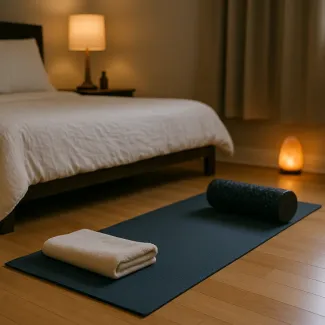
Improve your nights with movement: physical practices that prepare your body for restful sleep
A natural approach to better sleep through gentle bedtime activity
In a world where restless nights and fragmented sleep have become common companions, many are turning to non-invasive methods to calm the body and mind before bedtime. While many focus on nutrition or supplements, one of the most effective and sustainable solutions is intentional physical movement performed in the hours before sleep. This article delves into the transformative power of evening exercise routines, not in the form of intense workouts, but through gentle, calming practices that condition your body and nervous system for restorative, deep sleep.
How physical movement affects the sleep-wake cycle
Sleep is not simply a passive state. It's the culmination of a complex interplay between circadian rhythms, hormonal cycles, nervous system activity, and mental stress levels. One of the most powerful regulators of this system is movement. Not just any movement, but the kind that speaks directly to your parasympathetic nervous system—the one responsible for rest and recovery.
Engaging in low-impact physical activity in the evening hours helps trigger the body’s natural sleep mechanisms. Movement encourages temperature regulation, stimulates the release of serotonin, and gradually leads to a melatonin increase, setting the stage for deeper, more consistent sleep. Unlike caffeine, screens, or stress, which throw this balance off, calming body-based routines can reset your body’s internal cues in favor of better rest.
Why bedtime exercise is different from other workouts
While most people associate exercise with energy and stimulation, bedtime routines function on a very different level. These movements aren’t designed to elevate the heart rate or push muscular endurance. Instead, they focus on gentle stretching, joint mobility, mindful breathing, and fluid transitions between positions. Such movements foster neuromuscular relaxation, reduce muscle tension built up from the day, and create a physical sensation of letting go—which is crucial when preparing to sleep.
In fact, performing the right movements before bed can have a similar impact on the nervous system as guided meditation or deep breathing techniques, yet many find it easier to focus when they’re moving rather than sitting still. These routines are especially beneficial for individuals who suffer from racing thoughts, chronic tension, or a sense of restlessness in the evening hours.
Recognizing your body’s stress signals at night
Modern stress isn’t always dramatic. It often manifests as shallow breathing, tight hips or shoulders, difficulty settling into bed, or waking multiple times during the night. These physical cues are the body's way of signaling that the nervous system remains in an activated state, even when we think we’re relaxed.
By incorporating physical rituals before bed, you can help your body recognize that it’s time to shift into a state of restoration. These rituals need not be long or complex—just intentional and consistent. Over time, they can help to retrain your nervous system to wind down naturally as part of your sleep routine.
The best types of movement to prepare for sleep
There’s no one-size-fits-all prescription, but several categories of movement have proven especially effective for encouraging better sleep. These include:
- Slow stretching sequences, particularly those targeting the hips, spine, neck, and shoulders.
- Breath-led mobility routines, such as those found in Tai Chi or Qi Gong, which help center the breath with movement.
- Gentle yoga postures, especially restorative or yin yoga, which emphasize long holds and deep breathing.
- Foam rolling or self-massage, which helps release physical tension and increase circulation.
- Floor-based movement, such as rolling, rocking, or gentle spinal twists performed on a mat.
- Barefoot walking or grounding, either indoors or outside, which can settle the nervous system by reconnecting to a natural rhythm.
The key is that these exercises should not spike your adrenaline, elevate your core temperature too much, or make you feel physically “wired.” Rather, they should feel like a physical sigh of relief—an invitation to descend into sleep, not a push toward more output.
How to build your own bedtime movement routine
Your personal sleep preparation practice doesn’t need to be lengthy. In fact, the most sustainable routines are those that can be performed in 10–15 minutes and are easily repeatable. Here’s how to construct an effective pre-sleep movement habit:
Start by setting a consistent time to begin. This might be 30–60 minutes before your intended bedtime. Use this as a cue for your body to begin shifting gears.
Choose three to five exercises that feel good in your body. Aim for full-body participation, even if it’s subtle. A common sequence might include a forward fold, spinal twist, hip opener, shoulder release, and supine breathing pose.
Move slowly and with intention. Let each movement be accompanied by steady, deep breaths, and use the exhale to release tension.
Avoid screens and overhead lights during this time. Instead, consider dim lighting, soft instrumental music, or complete silence to deepen the effect.
Practice consistency over variety. The more regularly you perform the same sequence, the more your nervous system begins to associate those movements with relaxation and sleep.
Bedtime movement for people with sleep disorders
If you struggle with insomnia, restless leg syndrome, or early morning awakenings, bedtime movement can be a gentle intervention. These conditions often involve overactivity in the sympathetic nervous system, which can be rebalanced through deliberate, calming motion.
The focus should be on movements that reduce inflammation, encourage circulation, and stimulate the vagus nerve, which helps shift the body into a parasympathetic (rest-and-digest) state. Pay close attention to breath tempo, as slowing the breath helps reduce nighttime cortisol levels and enhances melatonin production.
This approach can be particularly effective for individuals who find traditional meditation frustrating or who experience physical agitation that prevents sleep. With consistent bedtime movement, these symptoms can gradually ease over time.
The role of breathwork during bedtime activity
Breath is the bridge between the conscious and subconscious states. Every bedtime routine should integrate breath awareness, regardless of the specific movements involved. Simple breathing techniques can amplify the calming effects of physical practice and accelerate the nervous system’s descent into sleep readiness.
You can start with box breathing (inhaling for 4 counts, holding for 4, exhaling for 4, holding for 4), or use 4-7-8 breathing (inhale for 4, hold for 7, exhale for 8). Pair these techniques with gentle stretching to enhance both mobility and calmness.
Another option is diaphragmatic breathing, which involves expanding the belly on each inhale and relaxing it on each exhale. This form of breath control helps signal safety to the brain and allows the entire system to release tension accumulated during the day.
Movement as ritual: creating emotional safety before bed
The effectiveness of bedtime movement goes beyond muscle relief or oxygenation. It taps into a deeper need for ritual and emotional containment. In many cultures, evening rituals were once commonplace—lighting candles, preparing herbal infusions, storytelling, prayer, or simply resting beside loved ones. These rituals told the body it was safe to surrender the day.
By performing a set sequence of calming physical movements, you reclaim a version of this ritual. You remind your nervous system that there is closure to the day, that the demands of productivity are over, and that it’s safe to release control.
Many people find that their sleep improves not just because of the physical benefits, but because they’ve established a space in which their body and mind feel welcomed into sleep.
The power of consistency in sleep-enhancing movement
While results can be felt after just one session, the most profound benefits come from sustained, daily practice. Consistency trains your brain to anticipate relaxation and primes the body to respond faster each night. The longer you maintain a bedtime movement routine, the easier it becomes to transition into deep, high-quality sleep.
Missing a day occasionally won’t undo your progress—but returning to your routine the next night helps maintain the rhythm. Even when you’re traveling or short on time, choosing two or three familiar movements can help you stay connected to your sleep rhythm.
Supporting hormone regulation with movement
Sleep and hormones are intimately linked. Poor sleep disrupts cortisol rhythms, reduces melatonin levels, and interferes with the production of growth hormone, which is essential for cellular repair. Meanwhile, hormones like ghrelin and leptin, which control hunger, can become dysregulated after a night of poor sleep, leading to increased cravings and metabolic disruption.
Gentle physical activity before bed has been shown to help regulate this hormonal cascade. It lowers evening cortisol, increases oxytocin, and enhances the release of natural melatonin. Over time, a consistent bedtime movement practice can lead to hormonal stability, improved mood, and fewer nighttime awakenings.
This is especially important for people experiencing perimenopause, thyroid imbalance, or adrenal fatigue, as bedtime movement offers a non-invasive way to restore internal balance.
Addressing emotional insomnia with movement
For many people, insomnia isn’t just physical—it’s emotional. Worry, grief, overstimulation, and unprocessed emotions can prevent the nervous system from settling. Bedtime movement becomes a tool for emotional discharge, helping you move stuck energy through the body before attempting to sleep.
Certain types of movement, such as swaying, gentle bouncing, or wringing motions, help the body mimic natural mechanisms of stress release. You may also incorporate sound—a soft hum or sigh on the exhale—to further facilitate the discharge of emotional tension.
These practices don’t eliminate emotion, but they help regulate it. They soften the edges of difficult feelings and make it easier to enter sleep without carrying the full emotional load of the day into bed.
Choosing the right movement for your sleep personality
Just as there are different chronotypes, there are different sleep personalities. Some people have naturally active minds that need more physical grounding. Others are physically tense and need passive release. Your bedtime movement routine should reflect this.
If you’re someone who lies awake overthinking, try a more somatic, full-body practice that engages the breath and joints. If your body feels tense and tight, start with stretching and static holds. If your nervous system is wired, but not in distress, go for slow movement patterns that mimic rocking or circular motion.
Let your body guide you, and adapt your routine as needed. The goal is to finish feeling heavy, relaxed, and centered, not activated.
Enhancing bedroom space for movement and calm
To fully benefit from bedtime movement, consider your environment. Your bedroom should support relaxation—free of bright lights, loud sounds, and digital distractions. If possible, designate a small space with a soft mat or rug, a blanket, and perhaps a few candles or salt lamp.
Keep your phone out of reach or on airplane mode, and avoid overhead lighting. A low-light space tells your body it’s time to prepare for rest. Add sensory support through lavender oil, calming music, or a weighted eye pillow.
Creating this intentional space enhances the impact of your bedtime practice and reinforces the brain’s association between this movement space and deep rest.
Using bedtime movement to improve sleep quality over time
The benefits of bedtime movement are cumulative. Each session builds on the last, helping regulate your nervous system, restore your hormonal balance, and condition your brain to expect safety and calm before sleep.
Over time, many people report fewer nighttime awakenings, faster sleep onset, and greater depth of sleep cycles. This also leads to better morning energy, improved focus, and stable mood throughout the day.
Rather than relying on external sleep aids, bedtime movement empowers you to reclaim your body’s innate ability to rest. It honors the rhythm of your day and offers your system a natural signal to let go.
Whether you choose gentle stretching, yoga nidra, mobility flows, or breath-led motion, the path to better sleep begins by inviting your body to move gently into stillness.
